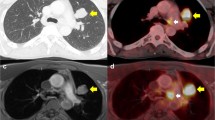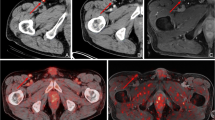Abstract
Purpose
The aim of this study was to evaluate the diagnostic value of contrast-enhanced CT (CECT) versus non-enhanced low-dose CT (NECT) in the staging of advanced malignant melanoma with 18F-fluordeoxyglucose (FDG) positron emission tomography (PET)/CT.
Methods
In total, 50 18F-FDG PET/CT examinations were performed in 50 patients with metastasized melanoma. For attenuation correction, whole-body NECT was performed followed by diagnostic CECT with contrast agent. For the whole-body PET, 18F-FDG was applied. Criteria for evaluation were signs of vital tumour tissue (extent of lesions, contrast enhancement, maximum standardized uptake value >2.5). Findings suspicious for melanoma were considered lesions. NECT, CECT and 18F-FDG PET were evaluated separately, followed by combined analysis of PET/NECT and PET/CECT. Findings were verified histologically and/or by follow-up (>6 months).
Results
Overall, 232 lesions were analysed, and 151 proved to be metastases. The sensitivity of NECT, CECT, PET, PET/NECT and PET/CECT was 62, 85, 90, 97 and 100%, and specificity was 52, 63, 88, 93 and 93%, respectively. Compared to CECT, NECT obtained additional false-negative results: lymph node (n = 19) and liver/spleen metastases (n = 9). Misinterpreted physiological structures mainly caused additional false-positive findings (n = 17).
In combined analysis of PET/NECT, six false-positive [other tumours (n = 2), inflammatory lymph nodes (n = 2), inflammatory lung lesion (n = 1), blood vessel (n = 1)] and five false-negative findings [liver (n = 3), spleen (n = 1), lymph node metastases (n = 1)] remained. On PET/CECT, six false-positive [inflammatory lymph nodes (n = 3), other tumours (n = 2), inflammatory lung lesion (n = 1)] and no false-negative findings occurred. However, additional false findings on PET/NECT (6 of 232) did not change staging compared to PET/CECT.
Conclusion
Our results indicate that it is justified to perform PET/NECT instead of PET/CECT for melanoma staging.



Similar content being viewed by others
References
Garbe C, Hauschild A, Volkenandt M, Schadendorf D, Stolz W, Kortmann RD, et al. Brief guidelines: malignant melanoma of the skin. J Dtsch Dermatol Ges 2006;4:344–9.
Garbe C, Hauschild A, Volkenandt M, Schadendorf D, Stolz W, Reinhold U, et al. Evidence and interdisciplinary consense-based German guidelines: diagnosis and surveillance of melanoma. Melanoma Res 2007;17:393–9.
Hany TF, Steinert HC, Goerres GW, Buck A, von Schulthess GK. PET diagnostic accuracy: improvement with in-line PET-CT system: initial results. Radiology 2002;225:575–81.
Antoch G, Saoudi N, Kuehl H, Dahmen G, Mueller SP, Beyer T, et al. Accuracy of whole-body dual-modality fluorine-18-2-fluoro-2-deoxy-D-glucose positron emission tomography and computed tomography (FDG-PET/CT) for tumor staging in solid tumors: comparison with CT and PET. J Clin Oncol 2004;22:4357–68.
Nutt R. 1999 ICP Distinguished Scientist Award. The history of positron emission tomography. Mol Imaging Biol 2002;4:11–26.
Friedman KP, Wahl RL. Clinical use of positron emission tomography in the management of cutaneous melanoma. Semin Nucl Med 2004;34:242–53.
Fuster D, Chiang S, Johnson G, Schuchter LM, Zhuang H, Alavi A. Is 18F-FDG PET more accurate than standard diagnostic procedures in the detection of suspected recurrent melanoma? J Nucl Med 2004;45:1323–7.
Kumar R, Alavi A. Clinical applications of fluorodeoxyglucose–positron emission tomography in the management of malignant melanoma. Curr Opin Oncol 2005;17:154–9.
Rinne D, Baum RP, Hör G, Kaufmann R. Primary staging and follow-up of high risk melanoma patients with whole-body 18F-fluorodeoxyglucose positron emission tomography: results of a prospective study of 100 patients. Cancer 1998;82:1664–71.
Jiménez-Requena F, Delgado-Bolton RC, Fernández-Pérez C, Gambhir SS, Schwimmer J, Pérez-Vázquez JM, et al. Meta-analysis of the performance of (18)F-FDG PET in cutaneous melanoma. Eur J Nucl Med Mol Imaging 2009;37:284–300.
Krug B, Dietlein M, Groth W, Stützer H, Psaras T, Gossmann A, et al. Fluor-18-fluorodeoxyglucose positron emission tomography (FDG-PET) in malignant melanoma. Diagnostic comparison with conventional imaging methods. Acta Radiol 2000;41:446–52.
Wagner JD, Schauwecker DS, Davidson D, Wenck S, Jung SH, Hutchins G. FDG-PET sensitivity for melanoma lymph node metastases is dependent on tumor volume. J Surg Oncol 2001;77:237–42.
Gulec SA, Faries MB, Lee CC, Kirgan D, Glass C, Morton DL, et al. The role of fluorine-18 deoxyglucose positron emission tomography in the management of patients with metastatic melanoma: impact on surgical decision making. Clin Nucl Med 2003;28:961–5.
Horn J, Sjøstrand H, Lock-Andersen J, Loft A. PET scanning for malignant melanoma and positive sentinel node diagnostics. Ugeskr Laeger 2010;172:1126–30.
Beyer T, Townsend DW, Brun T, Kinahan PE, Charron M, Roddy R, et al. A combined PET/CT scanner for clinical oncology. J Nucl Med 2000;41:1369–79.
Czernin J, Allen-Auerbach M, Schelbert HR. Improvements in cancer staging with PET/CT: literature-based evidence as of September 2006. J Nucl Med 2007;48:78S–88S.
Mottaghy FM, Sunderkötter C, Schubert R, Wohlfart P, Blumstein NM, Neumaier B, et al. Direct comparison of [(18)F]FDG PET/CT with PET alone and with side-by-side PET and CT in patients with malignant melanoma. Eur J Nucl Med Mol Imaging 2007;34:1355–64.
Reinhardt MJ, Joe AY, Jaeger U, Huber A, Matthies A, Bucerius J, et al. Diagnostic performance of whole body dual modality 18F-FDG PET/CT imaging for N- and M-staging of malignant melanoma: experience with 250 consecutive patients. J Clin Oncol 2006;24:1178–87.
Antoch G, Forsting M. How much CT does PET/CT need? Nuklearmedizin 2004;43:141–2.
Antoch G, Freudenberg LS, Beyer T, Bockisch A, Debatin JF. To enhance or not to enhance? 18F-FDG and CT contrast agents in dual-modality 18F-FDG PET/CT. J Nucl Med 2004;45:56S–65S.
Kuehl H, Antoch G. How much CT do we need for PEt/CT? A radiologist’s perspective. Nuklearmedizin 2005;44:S24–31.
Strobel K, Thuerl CM, Hany TF. How much intravenous contrast is needed in FDG-PET/CT? Nuklearmedizin 2005;44:S32–7.
Nading MA, Balch CM, Sober AJ. Implications of the 2009 American Joint Committee on Cancer Melanoma Staging and Classification on dermatologists and their patients. Semin Cutan Med Surg 2010;29:142–7.
Müller-Horvat C, Radny P, Eigentler TK, Schäfer J, Pfannenberg C, Horger M, et al. Prospective comparison of the impact on treatment decisions of whole-body magnetic resonance imaging and computed tomography in patients with metastatic malignant melanoma. Eur J Cancer 2006;42:342–50.
Krug B, Crott R, Roch I, Lonneux M, Beguin C, Baurain JF, et al. Cost-effectiveness analysis of FDG PET-CT in the management of pulmonary metastases from malignant melanoma. Acta Oncol 2010;49:192–200.
Gollub MJ, Hong R, Sarasohn DM, Akhurst T. Limitations of CT during PET/CT. J Nucl Med 2007;48:1583–91.
Buzaid AC, Tinoco L, Ross MI, Legha SS, Benjamin RS. Role of computed tomography in the staging of patients with local-regional metastases of melanoma. J Clin Oncol 1995;13:2104–8.
Cook GJ, Wegner EA, Fogelman I. Pitfalls and artifacts in 18FDG PET and PET/CT oncologic imaging. Semin Nucl Med 2004;34:122–33.
Rosenbaum SJ, Lind T, Antoch G, Bockisch A. False-positive FDG PET uptake–the role of PET/CT. Eur Radiol 2006;16:1054–65.
Aukema TS, Valdés Olmos RA, Wouters MW, Klop WM, Kroon BB, Vogel WV, et al. Utility of preoperative 18F-FDG PET/CT and brain MRI in melanoma patients with palpable lymph node metastases. Ann Surg Oncol 2010;17:2773–8.
Strobel K, Dummer R, Husarik DB, Pérez Lago M, Hany TF, Steinert HC. High-risk melanoma: accuracy of FDG PET/CT with added CT morphologic information for detection of metastases. Radiology 2007;244:566–74.
Veit-Haibach P, Vogt FM, Jablonka R, Kuehl H, Bockisch A, Beyer T, et al. Diagnostic accuracy of contrast-enhanced FDG-PET/CT in primary staging of cutaneous malignant melanoma. Eur J Nucl Med Mol Imaging 2009;36:910–8.
Klode J, Dissemond J, Grabbe S, Hillen U, Poeppel T, Boeing C. Sentinel lymph node excision and PET-CT in the initial stage of malignant melanoma: a retrospective analysis of 61 patients with malignant melanoma in American Joint Committee on Cancer stages I and II. Dermatol Surg 2010;36:439–45.
la Fougère C, Pfluger T, Schneider V, Hacker M, Bröckel N, Morhard D, et al. Restaging of patients with lymphoma. Comparison of low dose CT (20 mAs) with contrast enhanced diagnostic CT in combined [(18)F]-FDG PET/CT. Nuklearmedizin 2008;47:37–42.
Pfannenberg AC, Aschoff P, Brechtel K, Müller M, Klein M, Bares R, et al. Value of contrast-enhanced multiphase CT in combined PET/CT protocols for oncological imaging. Br J Radiol 2007;80:437–45.
Tateishi U, Maeda T, Morimoto T, Miyake M, Arai Y, Kim EE. Non-enhanced CT versus contrast-enhanced CT in integrated PET/CT studies for nodal staging of rectal cancer. Eur J Nucl Med Mol Imaging 2007;34:1627–34.
Pfannenberg AC, Aschoff P, Brechtel K, Müller M, Bares R, Paulsen F, et al. Low dose non-enhanced CT versus standard dose contrast-enhanced CT in combined PET/CT protocols for staging and therapy planning in non-small cell lung cancer. Eur J Nucl Med Mol Imaging 2007;34:36–44.
Rodríguez-Vigil B, Gómez-León N, Pinilla I, Hernández-Maraver D, Coya J, Martín-Curto L, et al. PET/CT in lymphoma: prospective study of enhanced full-dose PET/CT versus unenhanced low-dose PET/CT. J Nucl Med 2006;47:1643–8.
Brix G, Lechel U, Glatting G, Ziegler SI, Münzing W, Müller SP, et al. Radiation exposure of patients undergoing whole-body dual-modality 18F-FDG PET/CT examinations. J Nucl Med 2005;46:608–13.
Morcos SK, Thomsen HS. Adverse reactions to iodinated contrast media. Eur Radiol 2001;11:1267–75.
van der Molen AJ, Thomsen HS, Morcos SK, Contrast Media Safety Committee, European Society of Urogenital Radiology (ESUR). Effect of iodinated contrast media on thyroid function in adults. Eur Radiol 2004;14:902–7.
Laurent V, Trausch G, Bruot O, Olivier P, Felblinger J, Régent D. Comparative study of two whole-body imaging techniques in the case of melanoma metastases: advantages of multi-contrast MRI examination including a diffusion-weighted sequence in comparison with PET-CT. Eur J Radiol 2010;75:376–83.
Garg S, Kothari K, Thopate SR, Doke AK, Garg PK. Design, synthesis, and preliminary in vitro and in vivo evaluation of N-(2-diethylaminoethyl)-4-[18F]fluorobenzamide ([18F]-DAFBA): a novel potential PET probe to image melanoma tumors. Bioconjug Chem 2009;20:583–90.
Conflicts of interest
None.
Author information
Authors and Affiliations
Corresponding author
Rights and permissions
About this article
Cite this article
Pfluger, T., Melzer, H.I., Schneider, V. et al. PET/CT in malignant melanoma: contrast-enhanced CT versus plain low-dose CT. Eur J Nucl Med Mol Imaging 38, 822–831 (2011). https://doi.org/10.1007/s00259-010-1702-z
Received:
Accepted:
Published:
Issue Date:
DOI: https://doi.org/10.1007/s00259-010-1702-z




